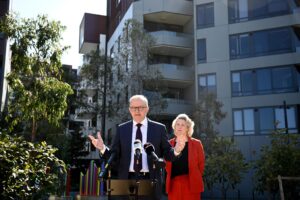The Climate Crisis Isn’t Just an Environmental One
This weekend, Canberrans can look forward to balmy back-to-back days in the mid-20s.
Across south-east Australia, temperatures will soar to 10-14 degrees above average. It’s only September – the Bureau of Meteorology forecasts it will get hotter and drier from here.
Australia is looking down the barrel of a sweltering summer, ripe for bushfires.
We are not the only ones facing climate disasters. This week, catastrophic floods have hit Libya and Greece. A month ago, fires made worse by climate change flattened Lahaina, Hawaii.
These events remind us as the cost-of-living crisis dominates discussions at the kitchen table and much of our political discourse, the climate crisis is still with us.
The reality is, of course, these two crises are inexorably linked.
Incoming Reserve Bank governor Michele Bullock has already demonstrated how intertwined these issues are, noting the impact of climate change on interest rates. And, by extension, on the cost of living: “The extra investment required to replace capital stocks destroyed by more frequent natural disasters or to transition to a lower-emissions economy could put upward pressure on the neutral rate.”
Alongside interest rate pressures, households and businesses are also facing increases in insurance premiums that are dramatically outpacing the consumer price index, exacerbating spikes that followed the Black Summer bushfires and subsequent severe flood events across Australia’s east coast.
Disasters are increasingly expensive for insurance companies, with the 2021-22 floods in Queensland and northern NSW costing insurers almost $6 billion. The knock-on effect on communities is premiums that are becoming increasingly prohibitive for those living in areas most vulnerable to floods, bushfires and cyclones. Often it’s regional and remote communities where such insurance is needed most.
If insurance becomes unaffordable in these areas – or worse, is not available at all, then purchasing a home or running a business becomes untenable. In such circumstances, community members will be left with very few options.
This week, the Australia Institute’s Climate of the Nation report found four in five Australians are concerned climate change will result in droughts and flooding, affecting crop production and food supply and leading to more bushfires.
More than 70 per cent of us are deeply concerned about the potential for climate change to exacerbate skyrocketing living costs – including insurance premiums.
Three-quarters of us are concerned climate change will make insurance premiums more expensive. The same number are concerned it will disrupt supply chains, making it harder to buy necessities.
To add salt to the wound, in a year where Australians are paying more, fossil fuel companies are enjoying record profits – including $140 billion on LNG and coal exports in 2023 alone – while exacerbating the climate change that will make cost of living worse.
It’s a twisted economic narrative where the polluters profit, and ordinary Australians pay the price – not just environmentally but economically and emotionally.
For communities devastated by disasters and unable to afford insurance – or access insurance at all, it is a price they could end up paying existentially.
Climate of the Nation makes it clear Australians want action against this inequality and accountability for the damage caused to our climate and the environment.
They want the fossil fuel companies to start paying the bill.
There’s a strong support base for a windfall profits tax on the oil and gas industry, backed by two-thirds of Australians.
Despite years of climate tax scaremongering, 74 per cent of Australians support a “polluter-pays” tax, with six in 10 people supporting a levy on fossil fuel exports to fund local government actions to mitigate climate change impacts.
Australians also see climate action presents opportunities for towns and communities in our regional areas, with two-thirds of us agreeing that it would drive new jobs and investment.
These are not fringe opinions; these are mainstream views held by Australians across the political spectrum.
And yet, we’re faced with political inertia and, more worryingly, harmful policy decisions.
The government is currently considering more than 100 new fossil fuel projects. A majority of people understand new coal, gas and oil projects will make it harder to reduce our greenhouse gas emissions by 43 per cent by 2020.
A fortnight ago, the environment minister approved the Gregory Crinum coal mine M Block expansion. The approval will last until December 31, 2073, and the mine will release 30 million tonnes of emissions over its lifetime.
Almost half of Australians feel the current government needs to do more to prepare for and adapt to the impacts of climate change and yet fossil fuel subsidies cost state, territory and federal governments $11.1 billion in 2022-23.
Unsurprisingly, people have had enough.
People have connected the dots between climate change and their financial wellbeing. They are frustrated with the inaction they see from their elected leaders and the systemic loopholes that allow fossil fuel companies to evade responsibility.
As a nation, we are willing to invest more in the short term for a sustainable future. We understand the climate crisis is not just an abstract environmental issue but a tangible, immediate economic one.
Between the Lines Newsletter
The biggest stories and the best analysis from the team at the Australia Institute, delivered to your inbox every fortnight.
You might also like
What kind of country do you want? | Between the Lines
The Wrap with Amy Remeikis What Peter Dutton and the Coalition are offering Australian voters is a fiction. It’s headlines without substance, chimeras and half-truths that never stand up to scrutiny, but comprehensively misdirects the media’s gaze. The nation has been in election mode since the beginning of the year, when Anthony Albanese used his
Ensuring workers’ safety in the climate crisis
As I watched the fires in Los Angeles unfold in January this year, my mind of course reflected on the 1999-2000 Black Summer bushfires in Australia. Both these seasons have wrought significant damage to humans and other animals, and to land, infrastructure and property. There has been a huge personal, collective and financial toll involved.
Fixing the housing crisis with Alan Kohler | Between the Lines
The big stories and the best analysis from the team at the Australia Institute, delivered to your inbox every fortnight-ish. Subscribe here.


